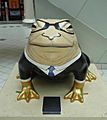Philip Larkin facts for kids
Quick facts for kids
Philip Larkin
|
|
|---|---|

Photograph by Fay Godwin (1970)
|
|
| Born |
Philip Arthur Larkin
9 August 1922 Coventry, England
|
| Died | 2 December 1985 (aged 63) Kingston upon Hull, England
|
| Resting place | Cottingham municipal cemetery |
| Monuments | Bronze statue, Martin Jennings (2010), Hull Paragon Interchange Station |
| Alma mater | St John's College, Oxford |
| Occupation | Poet, librarian, novelist, jazz critic |
| Employer | University of Hull (1955–85) |
|
Notable work
|
The Whitsun Weddings (1964), High Windows (1974) |
Philip Arthur Larkin (9 August 1922 – 2 December 1985) was an English poet, novelist, and librarian. He is known for his honest and sometimes sad poems about everyday life.
His first book of poetry, The North Ship, came out in 1945. He also wrote two novels, Jill (1946) and A Girl in Winter (1947). He became famous in 1955 with his second poetry collection, The Less Deceived. Later, he published The Whitsun Weddings (1964) and High Windows (1974).
Larkin was also a jazz critic for The Daily Telegraph from 1961 to 1971. His articles were collected in a book called All What Jazz. He also put together The Oxford Book of Twentieth Century English Verse (1973). He received many awards, including the Queen's Gold Medal for Poetry. In 1984, he was offered the job of Poet Laureate, but he turned it down.
After finishing his studies at Oxford University in 1943, Larkin became a librarian. He worked for thirty years as a university librarian at the Brynmor Jones Library at the University of Hull. Most of his famous poems were written during this time.
His poems often show a very English, honest look at feelings, places, and relationships. He once said that feeling a sense of loss was as important to him as daffodils were to the poet Wordsworth. Larkin was influenced by poets like W. H. Auden, W. B. Yeats, and Thomas Hardy. His poems have clear structures but are also flexible in their style.
Larkin was seen as a quiet, private Englishman who didn't like fame. Even almost two decades after his death, a 2003 survey chose him as Britain's most loved poet of the past 50 years. In 2008, The Times newspaper called him Britain's greatest writer since World War II.
In 1973, a reviewer called Larkin "the bard of Coventry," his birthplace. But in 2010, 25 years after he died, his adopted city, Kingston upon Hull, celebrated him. They held the Larkin 25 Festival, which ended with a statue of Larkin being unveiled. On 2 December 2016, a special stone memorial for Larkin was placed in Poets' Corner in Westminster Abbey.
Contents
Larkin's Life Story
Growing Up and School
Philip Larkin was born on 9 August 1922, in Coventry, England. He was the only son and younger child of Sydney and Eva Larkin. His father, Sydney, was the Coventry City Treasurer. He loved books and introduced Philip to many important writers. His mother, Eva, was a quiet and gentle person.

The Larkin family lived in Radford, Coventry, until Philip was five. Then they moved to a larger house near Coventry railway station. His sister, Catherine, was 10 years older than him.
Philip was taught at home by his mother and sister until he was eight. He didn't have many friends or visitors at home and developed a stammer. However, when he started at King Henry VIII Junior School in Coventry, he quickly made friends. He kept these friendships for a long time.
His parents supported his interests, especially his love for jazz music. They bought him a drum kit and a saxophone. He then went to King Henry VIII Senior School. He didn't do very well in his first school exams at 16. But he stayed on and two years later, he did very well in English and History. This allowed him to go to St John's College, Oxford, to study English.
Larkin started Oxford University in October 1940, during World War II. Because of his poor eyesight, he didn't have to join the military. This meant he could study for the full three years. At Oxford, he met Kingsley Amis, who became a close friend. They and other friends formed a group called "The Seven." They would talk about poetry, listen to jazz, and have fun. In 1943, Larkin was surprised to get a top degree in English, as he had spent a lot of time on his own writing.
Early Career and Relationships
In 1943, Larkin became a librarian in Wellington, Shropshire. There, he met his first girlfriend, Ruth Bowman, a 16-year-old schoolgirl. In 1945, Ruth went to London for her studies.
By 1946, Larkin was training to become a full librarian. He became an assistant librarian at University College, Leicester. His friend Kingsley Amis visited him there. Seeing the university's staff room gave Amis the idea for his famous novel Lucky Jim (1954).
After his father died in 1948, Larkin asked Ruth to marry him. That summer, they visited places important to the writer Thomas Hardy. In 1950, Larkin became a sub-librarian at The Queen's University of Belfast. Before he left, he and Ruth broke up. Around this time, he became friends with Monica Jones, an English lecturer at Leicester. He spent five happy years in Belfast. From 1951, he often went on holidays with Monica.
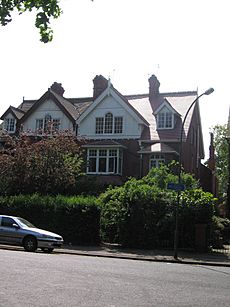
In 1955, Larkin became the University Librarian at the University of Hull. He stayed in this job until he died. A friend said that Larkin spent many hours in his office, working on library tasks and his own writing.
For his first year in Hull, he lived in rented rooms. In 1956, at 34, he rented a flat overlooking Pearson Park. This flat is thought to be the place he wrote about in his poem High Windows. Larkin liked Hull because it felt "on the edge of things," which suited him.
Hull University grew a lot after the war. Larkin worked hard to plan a new university library. He made important changes to the plans, and they were all accepted. The library was built in two stages. In 1967, it was named the Brynmor Jones Library.
Larkin became a very important figure in British librarianship. Ten years after the new library was finished, he made it the first in Europe to use a computer system for its records. This made it easier to find and borrow books. His colleague, Richard Goodman, said Larkin was an excellent manager. He treated his staff well and motivated them with efficiency, high standards, humor, and kindness. During his 30 years there, the library's collection of books grew six times larger.
Later Years and Achievements
In 1961, Larkin became romantically involved with his colleague, Maeve Brennan. She was a strong Roman Catholic. In 1963, she convinced him to go to a university dance, which he usually avoided. This event was important to their relationship, and he wrote about it in his unfinished poem "The Dance." Around this time, he also learned to drive and bought his first car.
Meanwhile, Monica Jones, whose parents had died, bought a holiday cottage. She and Larkin visited it often. His poem "Show Saturday" describes a local show they attended there.
In 1964, after The Whitsun Weddings was published, Larkin was featured on a TV arts show called Monitor. The show included an interview with fellow poet John Betjeman. This helped Larkin create his public image.
In 1968, Larkin was offered an award, the OBE, but he turned it down. Later in life, he accepted another honor, being made a Companion of Honour.
Larkin's work on the new Brynmor Jones Library was very demanding. After it was finished in 1969, he could focus on other projects. In 1970, he started putting together a new collection of poems, The Oxford Book of Twentieth Century English Verse (1973). He spent time at All Souls College, Oxford, to use the famous Bodleian Library.
Larkin played a big part in bringing attention back to the poetry of Thomas Hardy, which had been overlooked. His Oxford book included many poems by Hardy, as well as works by W. B. Yeats, W. H. Auden, and Rudyard Kipling.
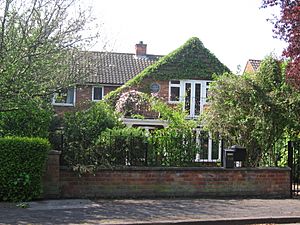
In 1974, Hull University told Larkin they would sell the building where he lived. Soon after, he bought a detached house in Newland Park. He moved in that June.
In 1976, Larkin was a guest on the BBC radio show Desert Island Discs. He chose music by artists like Louis Armstrong, Thomas Tallis, Edward Elgar, and Bessie Smith.
Final Years and Passing
Larkin turned sixty in 1982. This was celebrated with a collection of essays called Larkin at Sixty. There were also two TV shows about him.
In 1983, Monica Jones became very ill. Larkin was very worried about her. As her health got worse, she moved into his home in Newland Park and stayed there.

In 1984, after the death of John Betjeman, Larkin was asked if he would become the new Poet Laureate. He said no, partly because he felt he wasn't writing much poetry anymore.
The next year, Larkin became ill with oesophageal cancer. He had surgery in June 1985, but the cancer had spread. He collapsed in November and died four days later, on 2 December 1985, at age 63. He was buried in Cottingham municipal cemetery near Hull.
Before he died, Larkin asked for his diaries to be destroyed. This was done by Monica Jones and his secretary, Betty Mackereth. His other private papers were kept. Monica Jones later left a lot of money to several cathedrals.
Larkin's Creative Works
Early Writings
From his teenage years, Larkin wrote constantly. He wrote both poetry and five full-length novels, which he later destroyed. His first published poem, "Ultimatum," appeared in The Listener while he was at Oxford. He also created a fake identity, Brunette Coleman, under which he wrote two short novels.
After these, Larkin wrote his first published novel, Jill (1946). He then wrote A Girl in Winter (1947), which was published by Faber and Faber and received good reviews. He tried to write a third novel several times but never finished one.
Main Works
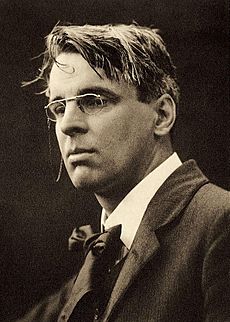
Larkin became a mature poet during his five years in Belfast. Most of his next poetry collection, The Less Deceived (1955), was written there. He also helped Kingsley Amis a lot with his novel Lucky Jim.
In 1954, an article first used the term The Movement to describe a new trend in British literature. Larkin's poems were included in a 1953 collection that also featured poems by Amis. Larkin was seen as part of this group. In 1951, Larkin printed 100 copies of his own collection called XX Poems. Many of these poems later appeared in his next book.
The Less Deceived was published in November 1955. At first, it didn't get much attention, but by December, it was on The Times newspaper's "Books of the Year" list. The book's popularity grew, and sales increased throughout 1956 and 1957.
During his first five years in Hull, Larkin wrote fewer poems, about two or three a year. But this period saw him write some of his most famous poems, like "An Arundel Tomb", "The Whitsun Weddings", and "Here".
In 1963, Jill was reissued. This led to the publication of The Whitsun Weddings the next year, which made his reputation solid. He was almost immediately made a Fellow of the Royal Society of Literature. In the following years, Larkin wrote more well-known poems. In the 1970s, he wrote longer, more serious poems like "The Building" and "The Old Fools." All of these appeared in his last collection, High Windows, published in June 1974.
Later in 1974, he started his final major published poem, "Aubade." It was finished in 1977 and appeared in The Times Literary Supplement. After "Aubade," Larkin wrote only one more poem that gained much attention, the very personal "Love Again," published after his death.
Larkin's Poetic Style
Larkin's poetry is known for its everyday, natural language. It has a clear, quiet, and thoughtful tone. He often used subtle humor and directly explored common experiences. One writer described his style as a "mix of beautiful language and unhappiness."
Larkin's early poems were influenced by Eliot, Auden, and Yeats. But his own unique style developed in the early 1950s, especially with the influence of Thomas Hardy. The "mature" Larkin style, seen in The Less Deceived, is like a calm, sometimes sad, sometimes gentle observer. He looked at "ordinary people doing ordinary things."
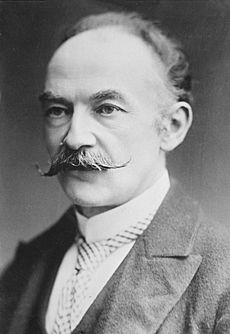
Larkin didn't like poems that relied on old stories or complex literary references. His poems are never filled with fancy images. His mature poetic voice is known for being plain and questioning. His poems often have surprising beginnings and clear, but flexible, structures.
One expert, Terence Hawkes, suggests that Larkin's style combines the symbolic moments of Yeats with the realistic settings of Hardy. Hawkes also believes Larkin's poetry deals with two main losses: the loss of a sense of wonder and the loss of the British Empire, which made England define itself in new ways.
In 1972, Larkin wrote "Going, Going," a poem that shows his romantic sadness about England. In it, he predicts the destruction of the countryside. He expresses a longing for a sense of national unity. The poem ends with the simple statement, "I just think it will happen, soon."
Larkin's style is closely tied to his main themes, like death and fate, as seen in his poem "Aubade." Poet Andrew Motion notes that Larkin's anger or scorn in his poems is always balanced by the strong energy of his language and his careful control of poetic forms. Motion describes Larkin's poetry as a "life-enhancing struggle between opposites." He concludes that Larkin's poems are often "ambivalent," meaning they show mixed feelings. They explore despair, show wide understanding, contain beautiful parts, and have influenced many poets after him.
Non-Fiction Prose
Larkin was critical of modernism in art and literature. His thoughtful opinions are best seen in Required Writing, a collection of his book reviews and essays. His strong opinions are also clear in his jazz reviews, All What Jazz. In this book, he criticized modern jazz and, more broadly, modern art. Larkin became known as someone who disliked modernism. However, some recent critics say his own writings actually have some modern characteristics.
Stories About Larkin's Life
In 1999, a play called Larkin With Women explored his long relationships. Another show, Pretending to Be Me, starring Sir Tom Courtenay, was based on Larkin's letters, interviews, diaries, and poems.
In 2003, BBC Two aired a play called Love Again, about the last thirty years of Larkin's life. Hugh Bonneville played Larkin. That same year, Channel 4 broadcast a documentary, Philip Larkin, Love and Death in Hull.
In 2008, BBC Radio 4 aired a play called Mr Larkin's Awkward Day. It told the story of a prank played on Larkin by his friend, Robert Conquest.
The Philip Larkin Society
The Philip Larkin Society is a group dedicated to remembering Philip Larkin and his works. It was started in 1995, ten years after he died. The society organizes lectures, walking tours, and events about Larkin and other writers of his time. In 2010, they held the Larkin 25 art festival to celebrate the 25th anniversary of his death.
Memorials to Larkin
In Kingston upon Hull, where Larkin worked and wrote much of his poetry, there are several memorials. The Larkin Building at the University of Hull has classrooms and lecture halls. The Philip Larkin Centre for Poetry and Creative Writing hosts literary events.
In May 2022, Larkin's childhood school, King Henry VIII School, opened "The Philip Larkin Room" as a memorial.
In 2010, Hull celebrated the 25th anniversary of his death with the Larkin 25 Festival. A video was made for his poem "Here," which celebrates Hull. Forty decorated toad sculptures, called "Larkin with Toads," were displayed in the city. This was a tribute to his poem "Toads."
A large bronze statue of Larkin by Martin Jennings was unveiled at Hull Paragon Interchange on 2 December 2010. It has a line from his poem, The Whitsun Weddings: "That Whitsun I was late getting away." Five plaques with Larkin's poems were added to the floor near the statue in 2011.
In June 2015, it was announced that Larkin would be honored with a floor stone memorial in Poets' Corner in Westminster Abbey. The memorial was unveiled on 2 December 2016. It includes two lines from his poem "An Arundel Tomb".
From July to October 2017, the Brynmor Jones Library in Hull held an exhibition called "Larkin: New Eyes Each Year." It showed items from Larkin's life and his personal book collection. Also in 2017, a pub in Coventry was renamed "The Philip Larkin."
Images for kids
-
Sculpture of Larkin as a toad, displayed during the Larkin 25 Festival in 2010, Kingston upon Hull
-
Blue plaque at Queen's University Belfast
List of Works
Poetry
- The North Ship. The Fortune Press. 1945. ISBN 978-0-571-10503-8.
- XX Poems. Privately Printed. 1951.
- The Less Deceived. The Marvell Press. 1955. ISBN 978-0-900533-06-8.
- "Church Going"
- "Toads"
- "Maiden Name"
- "Born Yesterday" (written for the birth of Sally Amis)
- "Lines on a Young Lady's Photograph Album"
- The Whitsun Weddings. Faber and Faber. 1964. ISBN 978-0-571-09710-4.
- "The Whitsun Weddings"
- "An Arundel Tomb"
- "A Study of Reading Habits"
- "Home is So Sad"
- "Mr Bleaney"
- High Windows. Faber and Faber. 1974. ISBN 978-0-571-11451-1.
- "This Be The Verse"
- "Annus Mirabilis"
- "The Explosion"
- "The Building"
- "High Windows"
- Thwaite, Anthony, ed. (1988). Collected Poems. Faber and Faber. ISBN 0-571-15386-0.
- "Aubade" (first published 1977)
- "Party Politics" (last published poem)
- "The Dance" (unfinished & unpublished)
- "Love Again" (unpublished)
- Thwaite, Anthony, ed. (2003). Collected Poems. Faber and Faber. ISBN 978-0-571-21654-3.
- The North Ship
- The Less Deceived
- The Whitsun Weddings
- High Windows
- Two appendices of all other published poems, including XX Poems
- Burnett, Archie, ed. (2012), The Complete Poems, Faber and Faber, ISBN: 978-0-571-24006-7
Fiction
- Jill. The Fortune Press. 1946. ISBN 978-0-571-22582-8.
- A Girl in Winter. Faber and Faber. 1947. ISBN 978-0-571-22581-1.
- James Booth, ed. (2002). "Trouble at Willow Gables" and Other Fiction 1943–1953. Faber and Faber. ISBN 0-571-20347-7.
Non-fiction
- All What Jazz: A Record Diary 1961–1971. Faber and Faber. 1985. ISBN 978-0-571-13476-2.
- Required Writing: Miscellaneous Pieces 1955–1982. Faber and Faber. 1983. ISBN 978-0-571-13120-4.
- Further Requirements: Interviews, Broadcasts, Statements and Book Reviews 1952–1985. Faber and Faber. 2001. ISBN 978-0-571-21614-7.
- Larkin, Philip (1979). "The Brynmor Jones Library 1929–1979". In Brennan, Maeve. 'A Lifted Study-Storehouse': The Brynmor Jones Library 1929–1979, updated to 1985. Hull University Press. 1987. ISBN 0-85958-561-1.
- Larkin, Philip, ed. (1973). The Oxford Book of Twentieth Century English Verse. Oxford University Press. ISBN 978-0-19-812137-4.
- Thwaite, Anthony, ed. (1992). Selected Letters of Philip Larkin, 1940–1985. Faber and Faber. ISBN 0-571-17048-X.
- Thwaite, Anthony, ed. (2010). Letters to Monica. Faber and Faber. ISBN 0-571-23909-9.
See also
 In Spanish: Philip Larkin para niños
In Spanish: Philip Larkin para niños


